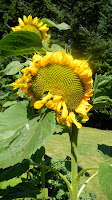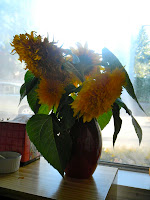"It is well to cultivate a friendly feeling towards error,
to treat it as a companion inseparable from our lives..."
Our classroom holds a multitude of activities which begin to build a child's ability to write and read. Many are on the three "language" shelves, which hold a long sequence from "I spy" games to the sandpaper letters to the movable alphabets to the farm. But language is everywhere, and we have so many ways to build vocabulary, to practice pencil grip, or to draw a child's attention to letters, words, or ideas, as their shared lives unfold in our rich environment.
When a child knows most of the sound/symbol correspondence of the alphabet, he begins a long practice period with the movable alphabet and phonetic words. Every child starts this work at his own time, and at his own pace. Most become quite engaged when they are four, and their work building these basic skills will continue through until they are five and six. Often parents don't see these activities, because they can usually spell words with the movable alphabet before they can write them down with paper and pencil.
Individual literacy trajectories are unique, and the children's "explosions into writing," as Dr Montessori called them, are always a joy, and often a surprise. How wonderful and empowering it is when a child realizes that he can express himself in writing!
One way I have always encouraged this free expression is with the "story folders." These are three-hole colored folders which the children keep here all year, using paper with room for a picture on top and up to three lines of words on the bottom. Getting a "story folder" is a special event, and right now five of our kids have them, with more just around the corner. In this work, the children draw a picture, write what they can, first with the movable alphabet, and then on the paper, and we NEVER correct them (sometimes I write very tiny in the bottom corner what the words say, if we might not remember later!) Here are three examples:
Cooper has such a passion for vehicles, and he was so excited to get a story folder. On this page he drew an ambulance, and then found "a m s" in the movable alphabet - the three sounds he heard and knew as he said this long word slowly to himself. I dotted the letters for him on the paper, at his request. On other pages he has done a "truc," a "monstr troz" (monster truck), a "pEnd" (panda), and his first sentence, "trans go fast."
By saving these papers all together in a folder, we can see their progress through the months, and they can look back at their own work.
June Marie did this one, a princess. She wrote "p r i s s." She had clearly seen the word, and remembered those two 's's at the end, as she laid it out with the movable alphabet. Isn't this drawing a wonderful princess?
On her latest pages, she's been drawing groups of friends, with some of their names. One says "TARA CARA JUNE TREVOR." We have some interesting examples of our inconsistent language in their names, like Terra and Cara. They rhyme, but they are spelled differently (which June Marie hasn't noticed yet.)
Or the 'c' and 'k.' We have Konrad and Kai for 'k,' and Cooper and Cara for 'c.' So when the older kids are spelling a word with that sound, they have already learned to ask, "Is it the Cara 'c' or the Kai 'k'?" It's actually very handy!
Finally, here is a page Terra did after a week-end at the beach. "betifl sand BeTifl sea." This is a good example of the way that they might intermix capital and lower case letters. We always teach lower case, the movable alphabets are lower case, and we hope that you will use lower case at home, but so many early books and media use cap's. Soon enough, the kids spontaneously transpose them in their heads. In the case of 'b' for her beautiful 'betifl,' Terra knew both, and used one each time, without even noticing. For 'sea,' she asked me, and I showed her that one way we spell the long 'e' sound is 'ea.'
I keep thinking of the adult book called Writing Down the Bones. This work is the children first writing down their bones, the memories and stories and moments that are important to them in their young and precious lives, day by day.
I keep thinking of the adult book called Writing Down the Bones. This work is the children first writing down their bones, the memories and stories and moments that are important to them in their young and precious lives, day by day.




